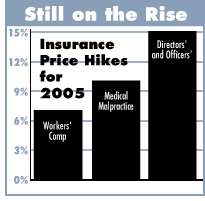

10/2004
The economy • Business costs • Finances
The economy
There’s another soft patch on
the way:
Early in 2005, the economy will slow.
Blame it on energy costs ... $50 a barrel or thereabouts for oil at least
through summer. What’s more, the highly volatile combination of brisk
world demand for oil and natural gas, U.S. refiners’ trouble building
inventories, and the political ills of producer nations spells huge risk.
Odds of prices spiking higher are a whole lot greater than odds they’ll
drop.
First-quarter GDP growth ... less than
3% as high heating bills slam
consumers and businesses take a rest after a buying spree in late 2004
before some key tax breaks expire.
By spring, the pace will pick up a bit as heating costs abate. But relief
from fuel cost woes won’t be complete. While other fuel prices
are easing, the tab at gasoline pumps will head higher into the summer.
For 2005 as a whole, growth still won’t edge much higher than 3%, about the same as in 2003 and a full percentage point below this year.
Flagging consumer spending accounts for most of the slowdown, with the pace of growth slipping under 3%, the slowest rate since 2001. In addition to being burdened by sky-high fuel bills, American consumers will lose the lubrication that fresh tax cuts have given to spending each year since 2001. And with mortgage interest rates likely to climb from 5.7% to 7% by year-end 2005, cash-freeing refinancings will be rare. Although job growth will quicken, it won’t be enough to offset the drags.
Energy woes also mean business spending
can’t play the rescuer. Shipping surcharges and price hikes for energy-intensive raw materials,
plus the cost of fuel itself, will sap business investment strength.
And in the face of subpar consumer spending, there’s waning enthusiasm
for expanding. So business spending growth will shrink from 10% to 7%.
Compounding the problem: Reined-in export
markets, as fuel prices erode
demand in Europe and Asia, limiting increases in exports to 8%.
Some particular industries will take the brunt of the blow:
Makers of energy-intensive goods, of course. Global competition means
that manufacturers of paper, plastics, chemicals, and aluminum, for
example, must absorb most of the cost hike rather than pass it on.
Industrial equipment and IT manufacturers, as potential buyers reapportion
their budgets and delay nonessential upgrades and expansions.
And retailers, who’ll be hit up for surcharges on shipping costs.
Rural economies are also vulnerable as farmers face rising bills for
fossil-fuel-based fertilizers, vehicle fuels, livestock heating, etc.
 Business costs
Business costs
A welcome respite from rate hikes for SOME insurance coverage:
Property and liability policies won’t cost much more, on average,
next year than this year. After increasing by 15% in 2003 and a whopping
25%-30% the year before, property insurance rates are finally stabilizing.
Areas hit by hurricanes are in for more
bad luck, though ... another
set of rate jumps of about 10%.
Still headed up: Medical malpractice, directors’ and officers’ liability,
and workers’ comp.
And prospects for terrorism insurance
are iffy. Some insurers will balk
at extending coverage beyond 2005, when legislation requiring the feds
to help pay losses on huge claims expires.
Finances
Small businesses are being wooed by
national and regional banks seeking
a bigger piece of a market once ruled by community banks. Already,
nearly half of smalls’ loans are held by the 58 largest banks.
And the bigger banks are pushing corporate credit cards for small firms.
Card numbers will top 12 million by year end, up from 4 million in
2000.
Higher fees are back for some 7(a)
loan guarantees from the Small Business Admin. The fees were lowered after 9/11 to spur growth. The SBA also
stopped piggybacking other loans on those it guarantees. The practice
effectively lets banks lend more money to a given creditor. If Kerry
takes the White House, fee hikes will probably be reversed. Bush, however,
wants the higher fees to wean the program from subsidies.
Prepaid gift cards issued by banks
will soar in popularity, from sales
of $700 million in 2002 to more than $30 billion in 2007. Because they
can be used everywhere credit cards are accepted, gift cards can replace
cash advances for employee travel and be used as rewards. The cards come
with fraud protection and, if lost, are easily replaced. But be careful
... purchase and account maintenance fees erode their value.
Increased credit card competition spells better reward programs. The
Supreme Court ruled that MasterCard and Visa can’t stop banks affiliated
with them from offering American Express and Discover cards. As a result,
look for card issuers to grant more points per dollar or expand options
for redeeming points as they vie for customers.
© 2004 The Kiplinger Washington Editors, Inc.
![]()
 |
||
| Kiplinger
is your source for timely insight into the economy and government.
Visit their Web site for more information.
|
||